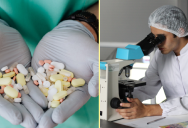There’s A New Antibiotic That Works Against Previously Resistant Bugs
You might have heard in recent years how new strains of bacteria are popping up that aren’t really able to be killed by antibiotics.
This is cause for concern, of course, because we definitely don’t want to go back to a world where we had nothing to fight the illness that could easily wipe us out.
Luckily, science is on that.
They’ve recently discovered an antibiotic that can get around the defenses of a typically drug-resistant bacterial species.

The bacteria is carbapenem-resistant Acinetobacter baumannii, or CRAB. Though it’s been resistant to modern antibiotics, this new drug employs a new attack strategy that seems to be working.
Kenneth Bradley, one of the drug’s developers. explains why.
“The advantage of a novel class of fully synthetic antibiotic is that bacteria have never seen this. The existing shields that CRAB uses to fend off antibiotics can’t block the new drug’s attacks.”
Bradley and his collaborators published a pair of papers on the topic, which were printed in Nature.
The drug is named zosurabalpin and is currently undergoing human trials.
Paul Hergenrother, a chemistry professor who was not involved in the research, is excited.
“This is very promising in that this is a new drug class and a new drug target. One would not expect cross-resistance with antibiotics that hit other targets.”
This is especially important since CRAB has been flagged as an “urgent threat” in the United States. It causes blood, urinary tract, lung and wound infections, and is particularly hard on people with weak immune systems who are already ill.

It’s “gram-negative,” which means it has a cell wall that’s surrounded by a membrane – and it’s been more than 50 years since antibiotics have worked against that type of bacteria.
This is mostly because it’s hard to penetrate the outer membranes and be able to stay inside long enough to do their job.
The researchers sought to get around this by finding an entirely new type of antibiotics.
“Instead of making new versions of the existing antibiotic scaffolds … we wanted to start with something completely different.”
They began by screening 45,000 chemical compounds for signs that they were active against bacteria like A. baumannii. They found one that they eventually modified into zosurabalpin – one that pretty much works only on it and not other bacterial infections.
“But at the same time, we identified safety flags. In addition to killing A. baumannii, it reacted with lipids in rodent blood, which harmed the animals.
They made this adjustment and many others before moving on to human trials with zosurabalpin. It works by disrupting the machinery that helps build the bacteria’s outer membrane.
“They were able to solve an actual atomic-resolution structure of the target bound to zosurabalpibn. There are actually molecular differences that would prevent the compound zosurabalpin from binding to other species of bacteria.”

Another bonus is that drugs with narrow targets have less of a chance of disrupting gut bacteria.
“A lot of your broad-spectrum antibiotics will really wipe out the gut microbiome. Hopefully zosurabalpin will prove to be microbiome-sparing, though that needs to be shown.”
The journey isn’t over, though, because CRAB will almost certainly begin to evolve accordingly.
“We fully expect that evolution will lead to the emergence of resistance at some point, but at least we’re not starting behind the ball on this one.”
That’s one reason the approval process for new drugs is so arduous, and zosurabalpin is just getting started.
Overall, though, drugs that target the development of that outer membrane will definitely be the focus of more research going forward.
If you think that’s interesting, check out this story about a “goldmine” of lithium that was found in the U.S. that could completely change the EV battery game.

Sign up to get our BEST stories of the week straight to your inbox.




